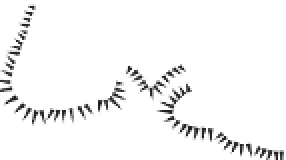Geology Reference
In-Depth Information
()
a
()
b
Poague
Cedar
Creek
L I M E STONE
B E LT
Natural
Bridge
Active
tributary
0
3 km
Figure 8.15
Natural Bridge, Cedar Creek, Virginia, USA. (a) Landscape before river piracy. (b) Landscape after river
piracy.
Source:
Adapted from Woodward (1936)
Natural bridges
lake waters in association with plants are called
tufa
(Colour Plate 5, inserted between pages 208 and 209).
Compact, crystalline, often banded calcium carbon-
ate deposits precipitated from spring, river, or lake
water are called
travertine
, or sometimes
calc-sinter
(Plate 8.13). However, some geomorphologists use the
terms tufa and travertine interchangeably. Tufa and
travertine deposition is favoured in well-aerated places,
which promote plant growth, evaporation, and car-
bon dioxide diffusion from the air. Any irregularity
Natural bridges
are formed of rock and span ravines
or valleys. They are productions of erosion and are
commoner in karst terrain than elsewhere. Three mech-
anisms seem able to build natural bridges in karst areas.
First, a river may cut through a very narrow band of
limestone that crosses its path. Second, cave roofs may
collapse leaving sections still standing. Third, rivers may
capture each other by
piracy
(Figure 8.15). This hap-
pens where meander caves on one or both sides of a
meander spur breach the wall of limestone between them
(Figure 8.15).
Tufa and travertine deposits
Karst rivers may carry supersaturated concentrations of
carbonates. When deposited, the carbonates may build
landforms. Carbonate deposition occurs when (1) water
is exposed to the atmosphere, and so to carbon diox-
ide, on emerging from underground; (2) when evap-
oration supersaturates the water; and (3) when plants
secrete calcareous skeletons or carbonate is deposited
around their external tissues. Porous accumulations
of calcium carbonate deposited from spring, river, or
Plate 8.13
Hot spring travertine terraces at Pummukale,
Turkey.
(
Photograph by Derek C. Ford
)



























